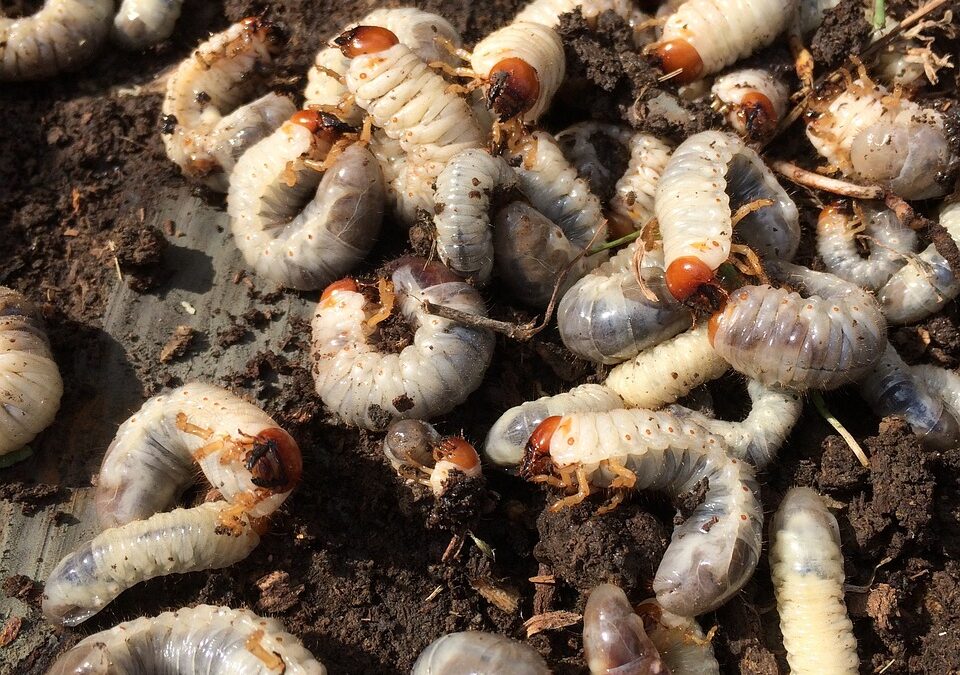Controlling Grubs in Your Lawn
Controlling grubs in your lawn is complicated. Grubs are the larval stage of various beetle species that can harm your grass. The most common culprits are Japanese Beetles, Masked Chafers, European Chafers, Green June Beetles, and May/June Beetles.
Grubs live underground, hidden from sight, but can cause significant damage. Because they feed on the roots of grass plants, usually during the mid to late summer months. So, as they continue to feed, it reduces the plant’s ability to effectively absorb water, causing the grass to wilt and die. The damage from grub feeding may not be immediately visible, but the signs will start to appear. After enough feeding, the lawn will look patchy and brown as the grass plants succumb to the lack of water.
Going to War with Grubs!
Preventative treatments can be applied early in the summer to combat grub infestations. Alternatively, spot treatments can be used once the initial signs of grub damage develop. Grubs also attract other lawn pests, such as birds, skunks, armadillos, raccoons, or moles. These animals often tear up the lawn as they try to uncover and eat the grubs.
Addressing the grub problem at the source is crucial to maintaining a healthy, lush lawn and avoiding secondary issues caused by the feeding activity of these pests. Grubs eat roots, killing your grass, and attract animals, such as moles, that can cause grave damage to your lawn. They also eat and damage plants.
For example, “Japanese Beetle is an invasive beetle accidentally brought to the US in the soil of ornamental plants. The grubs damage pastures and lawns by feeding on the roots of grasses. The adults overwhelm plants and skeletonize leaves. They eat over 300 species of plants, including crops, flowers, ornamentals, and fruits.” — Purdue.edu.
7 Steps to Controlling Grubs in Your Lawn
Inspect Your Lawn
Check for signs of grub damage, such as brown, patchy grass that you can easily pull up. The best time to inspect is in late summer or early fall when grubs are growing.
Identify the Grubs
Grubs are the larvae of beetles, such as the Japanese beetle, European chafer, or June beetle. Look for C-shaped, white grubs in the soil, usually 1-2 inches deep. Although similar, grubs do differ. So, knowing the type of grub invading your lawn can inform you of the best method to combat them. Cornell.edu — How to identify grubs.
Use Biological Controls
Beneficial nematodes are microscopic worms that can parasitize and kill grubs. Apply them in late summer or early fall. Some recommend Bacillus thuringiensis (Bt) products, which are bacteria that can kill grub larvae.
Apply Insecticides
Insecticides are effective when applied in late spring or early summer. Always follow the instructions on the product label carefully.
Aerate Your Lawn
Aerating the soil can help improve water and air movement, making it harder for grubs to survive. What Is Lawn Aeration and How Do You Know If Your Lawn Needs it?
Maintain a Healthy Lawn
Proper mowing, fertilizing, and watering can help your lawn resist grub damage. Because grubs are less likely to infest a thick, healthy lawn.
Hire Berger Hargis
Grubs can be challenging to target and hard to identify, which is critical when attempting to control an infestation. So, knowing what the grub is can make a difference when forming a plan to eradicate them. It’s always best to consult with a local lawn care professional if you have a severe grub problem. However, we think it’s even better to check with us before it becomes a severe problem.
How Can We Help You?
Berger Hargis has a company philosophy of providing personal excellence for all our services. Our growth and success have been due entirely to our commitment to honest, excellent customer service. The company is built on the referral business we have received due to this philosophy.
If we can answer any questions about controlling grubs in your lawn, please don’t hesitate to Contact Us.
So, if you’re looking for a career where you can have fun at work, call (317) 243-0100.
About the Author
Randy Clark is a speaker, coach, and author. He publishes a weekly blog at Randy Clark Leadership.com. Randy is passionate about social media, leadership development, and flower gardening. He’s a beer geek, and on weekends he can be found fronting the Rock & Roll band Under the Radar. He’s the proud father of two educators; he has four amazing grandchildren and a wife who dedicates her time to helping others. Randy is the author of the Amazon bestseller The New Manager’s Workbook, a crash course in effective management.
Image by BrianCarlin from Pixabay
Go Back








